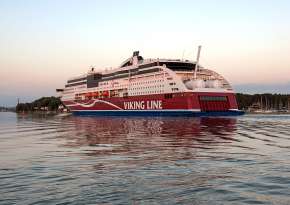Climate change brings green thinking to logistics

Green logistics is a concept consisting of various activities, and the goal to reduce the environmental impacts is included in the management of the whole supply chain. The promotion of green logistics is required by the European Union’s energy and climate strategy for year 2030, which sets tight goals for emissions, especially greenhouse gases.
Emission goals for traffic also concern the transport industry
Finland plays an important role in the European climate programme, as the Commission requires Finland to reduce its CO2 emissions by 39 per cent by 2030. In Finland, traffic is in key position regarding the targeted reduction. Emissions caused by traffic should be cut by half from the level of 2005 by year 2030.
The improved energy-efficiency of passenger cars and the obligation to use bio-fuels are expected to realise a large part of the targeted reductions, but emissions also need to be cut in the road transports of goods. The CO2 emissions of truck traffic in Finland currently total approximately three million tonnes, which should be reduced by about one-third. That will not be enough, however, but by 2050 the traffic should be completely emission-free. That goal will be impossible to reach without replacing fossil fuels with renewable ones, and the high price of the latter will cause considerable additional costs to road transports. Green logistics will be a solution for reducing both emissions and costs.
The whole supply chain has to work for the environment
“In practice, the realisation of the emission goals requires the minimising of the waste, emissions and energy consumption in different stages of the supply chain. Everyone can contribute to that, starting from product and package design. For the actual logistics operations, it concerns, for example, the selection of transport routes, modes of transport and equipment. In the planning of logistics, the possibilities for joint transports, storage, and purchasing and distribution channels need to be taken into account”, says Heikki Liimatainen, Professor at the Tampere University of Technology (TUT).
Professor Liimatainen, Doctor of Science (Technology), heads up the Transport Research Centre Verne at TUT which aims at promoting the development of a sustainable traffic and transport system. He is also a member of the Finnish Climate Panel.
”In the long term, the planning of the supply network is more important, although the present discussion focuses on vehicles and fuel technologies. In forest industry transports, for example, the trucks often drive empty in one direction, so the benefits of increased masses can only be utilised partially. In internal logistics within cities and regions, reductions in emissions can be achieved by using electric vehicles, and by combining shipments and rationalising the distribution routes. As a quarter of the total freight drives are empty, the decrease in under-utilisation will have great significance”, Heikki Liimatainen says.
Port of Turku is an active player in environmental issues
The Port of Turku supports the introduction of green logistics through its own operations. The Port has had certified environmental and safety systems in place since 2002, and the operations are continuously being developed together with own personnel and different stakeholders.
”Alongside our own operations, we invest in the development of the Port’s facilities, so that our partners at sea and on land can take the requirements of the environment into account in their operations. In order to improve the state of the Baltic Sea we pay special attention to the collection of waste water from vessels. The first fixed waste water points were built for passenger ferries in the 1980s, and three new reception points for cargo vessels and cruise liners were completed in 2016”, says Jaakko Nirhamo, Sales Director of the Port of Turku.
The non-existent congestions have a significant effect on reducing emissions caused by traffic in the Port of Turku. The fast turnaround times and smooth connections minimise the idling of trucks, both while waiting for access to the port and during loading.
”The use of alternative renewable fuels is also promoted by the first road fuel gas filling station in the Turku region right next to the Port. In addition to heavy vehicles, environmentally sound road fuel gas is available to passenger cars and buses.”
Published at Port of Turku Customer Magazine Aboard 2/2017.
